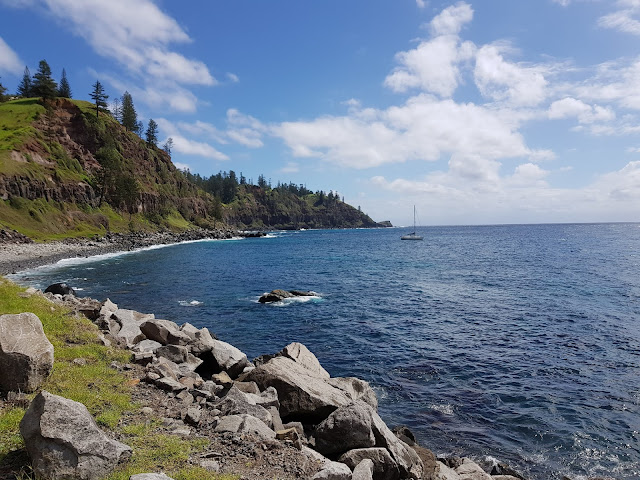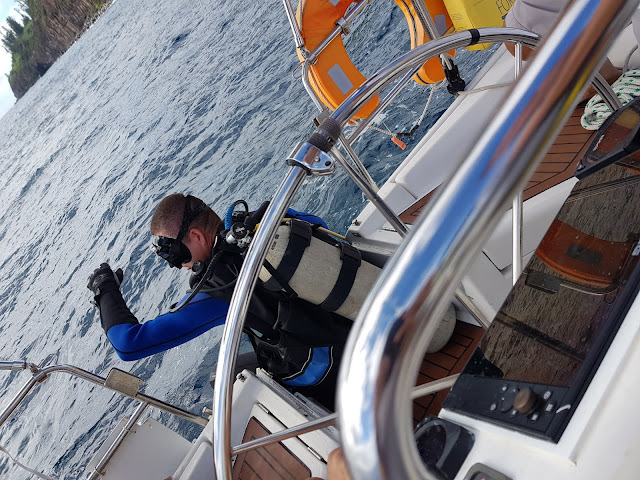 |
| On anchor off Cascade Bay in Norfolk, before all the fun started |
In April 2019, I set out to sail across Tasman Sea, from Auckland (NZ) all the way to Gold Coast, on a 44 ft Beneteau s/y Ocean Gem. This post is only about our anchoring adventures on Norfolk Island, as there was a lot to tell about that! To read about the sailing to and from there, you can go to another post. Yet another tells some history and my experiences on Norfolk Island.
By pure chance, we discovered the damage on the sail and the rigging, that had happened as a result of wear and tear on the way to here. There was a hole in the main sail (uncertain how the damage happened), and the rigging piece I had tightened before leaving Auckland was now loose - the steel had come off and it had unwinded. So the plan was to head back, anchor briefly and repair it all before heading off from Norfolk toward Gold Coast – and thus finishing our crossing of Tasman Sea.
We entered Cascade Bay in the dark. Most of us had not had any sleep since early morning, we had had a full day of hard work and exciting exploration, and the two that also were up all night mastering the trying passage in just a bit too much wind - they must have been exhausted.
 | |
|
The reparation required somebody going up the mast, and the swell was a bit too heavy for that. We considered coming alongside the pier, but promptly decided against it, as the surge was too big. We would have been smashing at the concrete pier, going 1-2 meters up and down every few seconds as the best case – worst case being picked up and spat out at the rocky beach before we ever could react or reverse. We opted for dropping the anchor again. That would be the secondary anchor, as the primary was out of service due to the pulpit steel piece getting snapped into two on the passage to New Zealand.
The secondary anchor was attached to a couple of meters of chain, rest being nylon line. I’m normally extremely paranoid about the line getting into the propeller, and try to do all possible risk mitigation to avoid that. It can apparently be considered overly protective, even. This time I did not do anything particular about it. Long story short, the line got stuck. This will definitely not help my paranoia about fouling the propeller… Anyway, the engine stopped, and now we were drifting towards the rocky beach, pushed along by swell and incoming tide.
 |
| A photo to show the vicinity of the rocks. Here - in lovely daylight. |
The secondary anchor was not assembled. The skipper got it out from the locker in no time, communicated what needed to be done, and all together we had ourselves anchored and out of danger, in ultrarapid speed. Then he called up the local police, who got us in touch with a local diver, who could come out already the next morning and remove the line from the prop. The close call was followed by a swift debrief, then a warm meal and a well deserved rest. It was an uneasy night, rocked about by swell hitting us right on the side, stuck in that position because of double anchor. Of course, I was troubled by the risk of too much force on the line which would damage the propeller shaft, or that the line would foul the rudder too, but there was nothing to do about it except releasing as much line as possible. Sleep was then the highest prio.
The diver arrived in the morning, a very pleasant guy called Doug. As he was putting on his gear, we asked about the tiger sharks, as we have heard that they would frequent the area. Doug told us that the fishing boats come to the South side of the island on Tuesdays and Sundays, clean the fish and through the offal into the sea. The sharks know it and apparently keep track of weekdays, so that’s the days when they are in Norfolk. Then Doug looked at his watch to check the day of the week: “Yeah, so it’s Tuesday today”, and continued to put on his gear. After all, the tiger sharks mostly stick to the south side of the island. And so he jumped in.
 |
| The sign on the pier. |
Shortly, we were free – and both the prop and the rudder looked undamaged! We retrieved the bitter end of the anchor line, but the one that was still attached to the anchor had to be marked with a floating buoy and retrieved later.How to transport the buoy and the line to the diver? I volunteered to swim up to the diver, to be frank mostly because I wanted the tickling experience of swimming in tiger shark waters. The water was amazingly clear, and very refreshing!
 |
| Swimming in tiger shark waters! |
We drove off the diver, retrieved the anchor line and the
secondary anchor, and now it was time to do the reparations. The sail was examined and we prepared a fix that was going to be applied as we were setting it. I was hoisted up the mast to inspect and fix the rigging. The boat rocked in the swell and threw me around, so the fix took some time, but at the end I had it arranged and secured. The bruises on the knees and elbows would serve as a reminder of this adventure during the next couple of days.
 |
| Hi from up high! |
After having done this, we were ready to get the primary anchor on board. As the pulpit piece was missing, we could not use the anchor winch. Retrieving it manually over the toe rail did not work either. Then the skipper proposed a solution: to haul it up using two halyards!
It worked quite well, despite the swell and the weight of chain. It was winched up with one halyard, and after a while another was attached and the first one lowered, to repeat it all over again. It went beautifully, until about 15 meters were left. Then, things started to be difficult. Suddenly, all the shackles, lines and fastenings were snapping! The chain would just not move, and as the boat spun around in the swell there were considerable forces to deal with. All of us realized that one wrong move could mean damage to fingers, hands, arms, feet, or even legs or head. No attachments held to the force on the chain, and I have never seen so much line snap in my entire sailing life. Two halyards snapped with such force that they wrapped around the top of the mast several times. It was clear we needed to abort this maneuver. The anchor was clearly stuck, and fighting the 10+ tons of force on the chain from the weight of the boat was not safe. At the end, we dumped in the chain to avoid damage.
We brought in the diver again. That sentence may take just a couple of seconds to read, but there is considerable effort behind it. The dinghy that had been deflated and carefully stowed for the second time, had to be inflated – by hand – for the third time during the past 24 hours, the outboard had to be lowered and attached again, the swell calling for extra precision and strength, and so on. By this time, the thought “will we ever leave Norfolk Island?” was spinning around in our heads. I looked at the crew and realized they have not had a meal since breakfast, now the sun is about to go down. I got out snacks, sodas, hot soups. The thousand miles stare slowly got replaced by a more vital look.
 |
| Doug, the friendly local diver - going in again! |
The diver took a look at the situation and confirmed that the anchor is stuck in a deep crevasse. He freed the anchor, and tried to take it on board the dinghy. The dinghy got filled with water and could not transport the heavy anchor, so there was a need for workaround. A line was tied to the end of the chain, and passed onto the boat which I was helming at the moment, trying to keep some steering speed but not get too far from the dinghy. We tried to pull it onboard. But it soon showed to be impossible - the line and the chain wouldn’t move. We were motoring at full speed, but did not move an inch.
The diver submerged again, just to tell us that the chain was stuck in the same crevasse as the anchor was residing in, going over it twice to really have us chained onto the sea bottom. He reported that he could definitely free it, but not now. The sun was going down, visibility was low, he was low on air, and it was prime feeding time for the sharks. He promised to come back first thing in the morning.
Instead of spending another night in the uncomfortable swell, David took the wise decision to dump both the anchor and the chain, and to move over to the lee side of the island. There, we hoisted a crew member up the mast to retrieve the halyards, as we now only had two left (for hoisting and safety) which ruled out sailing as a safe option in case anything else should happen. Being hoisted to the top of the mast, in the dark, while motoring, without ever having done it before is quite a challenge, but he did an excellent job. We also repaired the main sail - and thus we were all set for sailing. We reefed the main and did some relaxed sailing in two hour shifts, to ride out the night without having to anchor. There was no swell, the stars were out, and the lack of dramatic events was in stark contrast to the past two days.
In the morning of 10th of April, I went to get Doug at the dock, drove him to the crevasse in the dingy, and assisted in retrieving the chain. The broken pulpit piece was attached to the bow so now the anchor winch could be used. Me and Doug cheered from the dinghy as we saw the chain rise from the sea bottom and disappear inside of the boat! As all 40 meters are in, together with the anchor, it meant that we were free to go.
 |
| Ocean Gem bathing in the sunrise, off the anchor and ready to go from Norfolk, onwards! |
I made the last touchdown at Norfolk leaving Doug, and got back to Ocean Gem. We were leaving again, it was hard to believe, everyone was hopeful but we tried not to jinx it. Goodbye beautiful Norfolk. I’ll never anchor here again, that’s for sure.
